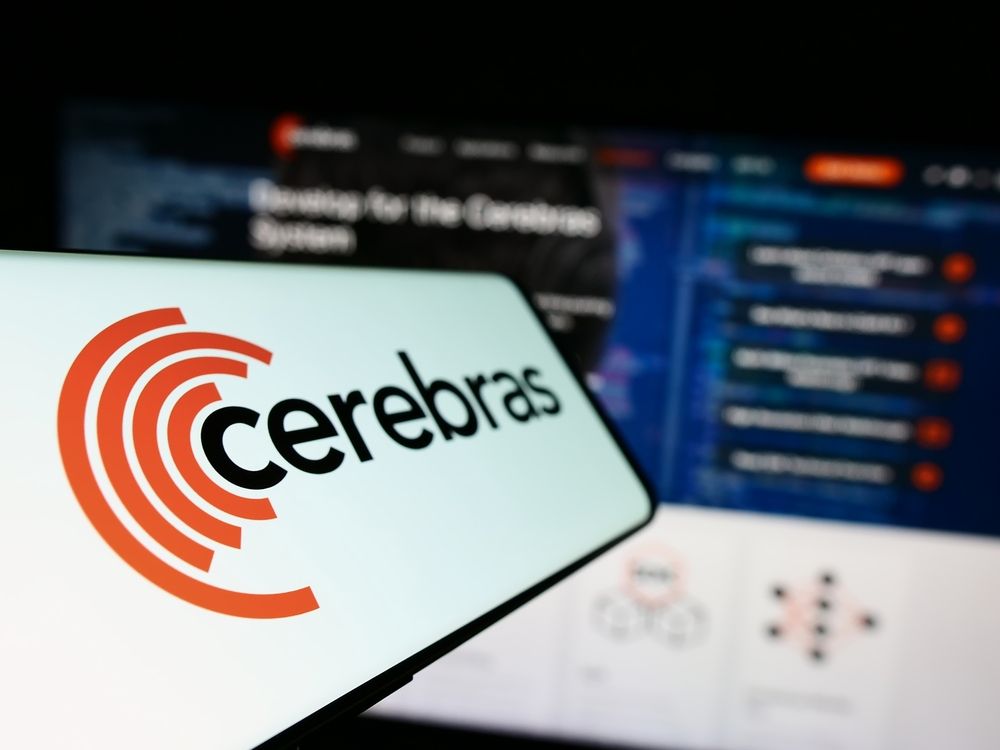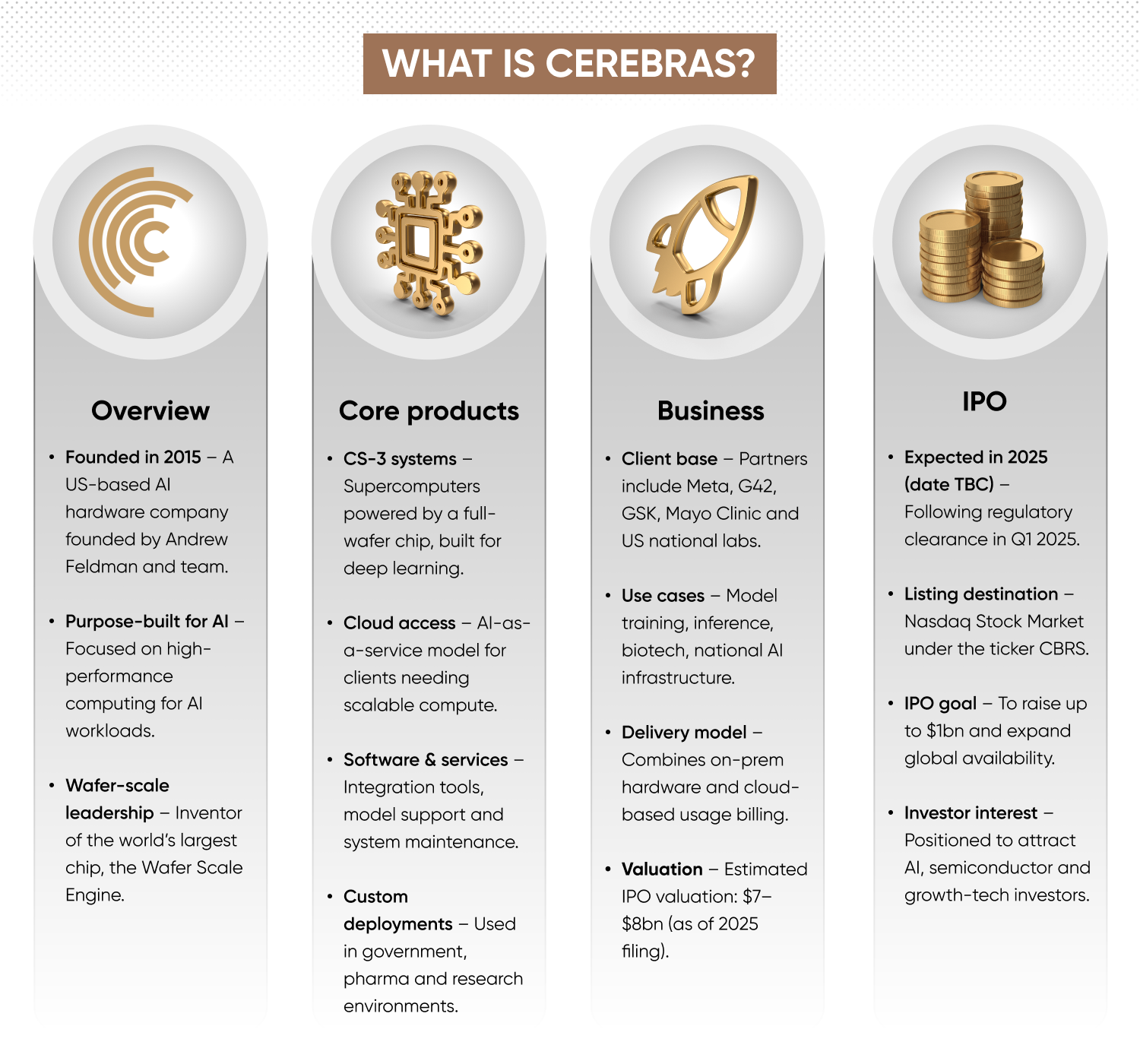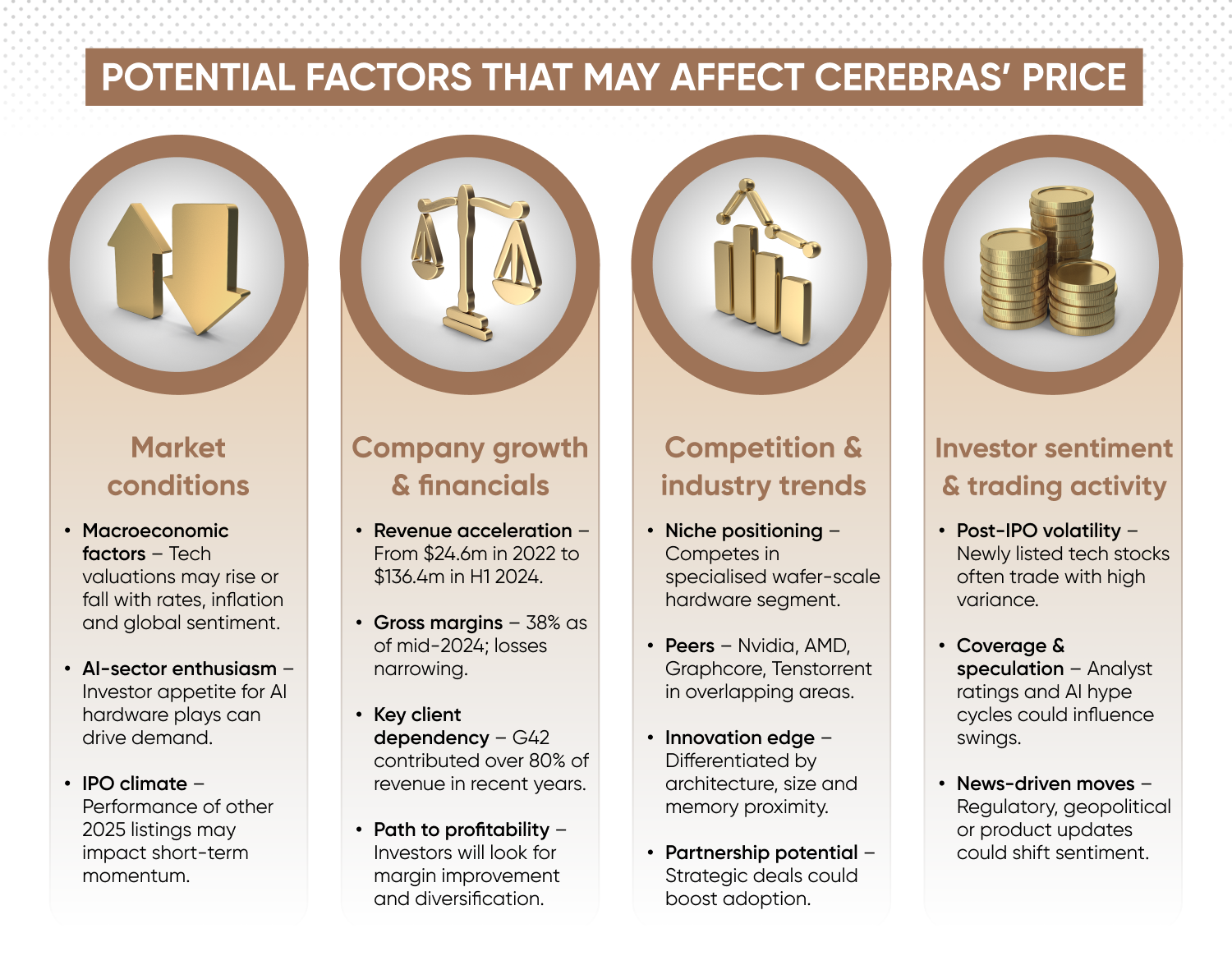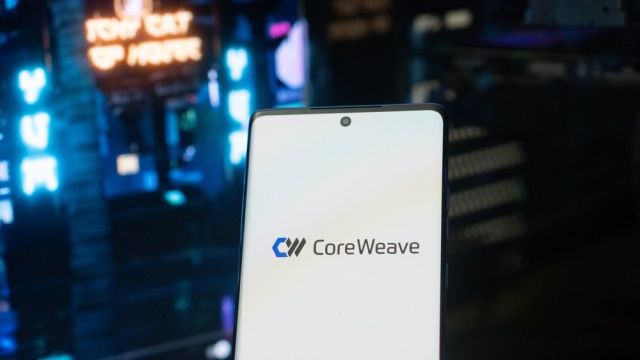Cerebras IPO – how to trade Cerebras shares

Learn about Cerebras and its upcoming IPO, what drives its stock price, and how to trade Cerebras stock via CFDs when it lists.
When is the Cerebras IPO date?
As of June 2025, Cerebras has not officially announced a confirmed date for its initial public offering (IPO). However, the company filed its S-1 registration with the SEC in late 2024 and is widely expected to list on the Nasdaq Stock Market under the ticker symbol CBRS in the second half of 2025.
The company is reportedly targeting a valuation of between $7bn and $8bn and aims to raise up to $1bn from the offering. This would mark a significant increase from its previous private valuation of $4bn in 2021.
Cerebras initially planned to go public in 2024 but delayed its listing following a review by the Committee on Foreign Investment in the United States (CFIUS), due to its business relationships with UAE-based G42. With that regulatory process now resolved as of March 2025, attention has turned to the IPO timing.
Several factors could influence the exact date of Cerebras’ public debut:
-
Financial performance: the company has shown strong revenue growth in recent years but remains unprofitable. Demonstrating consistent growth and improving margins may help support a successful listing.
-
Regulatory clearance: the recent CFIUS approval has removed a major hurdle, but further compliance and SEC review could still impact the timeline.
-
Market conditions: the broader sentiment around tech IPOs and demand for AI-related stocks will likely play a key role. A strong pipeline of AI chips and demand for infrastructure could accelerate plans.
While the company has cleared major hurdles, a precise date will depend on how receptive markets remain heading into the final two quarters of 2025.
What is Cerebras?
Cerebras Systems is a US-based semiconductor company focused on designing chips optimised for artificial intelligence (AI) and high-performance computing workloads. Founded in 2015 by Andrew Feldman and a team of engineers, it aims to remove the bottlenecks associated with conventional processors by offering an alternative architecture tailored for machine learning.
Its core innovation is the Wafer Scale Engine (WSE) – the world’s largest computer chip. Unlike traditional chips that use only part of a silicon wafer, the WSE spans the entire wafer, packing in hundreds of thousands of cores and trillions of transistors. This chip powers Cerebras’ CS-3 system, which is purpose-built for training and deploying large AI models.
Cerebras offers its systems both as physical hardware and via cloud-based access. Its customers span government labs, healthcare organisations and global tech firms, including Meta, G42, GlaxoSmithKline and Mayo Clinic. It also partners with national research labs for scientific computing and simulation projects. These collaborations help showcase the versatility and real-world application of Cerebras systems across a wide range of industries, from biotech to defence and academic research.
Key milestones in Cerebras' history
-
2015 – founded in Sunnyvale, California by Andrew Feldman and team
-
2019 – launched the first Wafer Scale Engine chip
-
2021 – reached a $4bn valuation in private funding rounds
-
2023 – recorded $78.7m in annual revenue with rapid growth
-
2024 – filed for IPO and expanded cloud offerings
-
2025 – preparing for Nasdaq listing with estimated valuation of $7bn-$8bn
Cerebras' key features
-
Wafer-scale chip architecture – dramatically expands processing speed and memory
-
CS-3 supercomputers – AI systems purpose-built for deep learning tasks
-
Cloud-based compute access – scalable pay-per-use model for AI workloads
-
Scientific partnerships – collaborations with US national labs and major research bodies
-
Hardware-as-a-service model – enabling clients to avoid large capital expenditure
The company continues to gain traction in the global AI infrastructure race and is considered one of the most promising semiconductor innovators targeting the future of large model training.

How does Cerebras make money?
Cerebras generates revenue through a combination of hardware sales, cloud usage, services and support. Below is a breakdown of its business model:
|
Revenue stream |
Description |
|
Hardware sales |
Direct sale of CS-3 systems, priced in the millions per unit |
|
Cloud usage |
AI-as-a-service model, clients pay to use systems hosted by Cerebras or partners |
|
Software & support |
Integration tools, firmware, training, updates, and performance optimisation |
|
Consulting services |
Custom model deployment, training pipelines, and long-term advisory work |
In H1 2024, Cerebras recorded $136.4m in revenue, up from $78.7m in 2023 and $24.6m in 2022. While the company remains unprofitable, losses have narrowed significantly year-over-year, and gross margins reached 41% by mid-2024.
What might influence the Cerebras live stock price?
Cerebras’ stock price, once listed, will likely be shaped by a combination of company-specific performance indicators, broader tech market trends, and regulatory dynamics. Below are several key factors that could affect the share price:
Financial performance
Revenue growth, gross margins, and progress toward profitability will be closely monitored. Cerebras has shown rapid top-line growth, but sustained improvement in margins and cost control will be critical for long-term valuation support.
Customer concentration risk
A large portion of Cerebras’ current revenue is derived from a single client, G42. While this relationship underscores commercial demand, any disruption or reduction in orders could raise concerns about diversification and financial resilience.
Sector sentiment and market momentum
As an AI infrastructure play, Cerebras will be sensitive to investor appetite for AI-related stocks. Positive news in the semiconductor or AI sector could lift sentiment, while broader tech sell-offs may have the opposite effect.
Competitive landscape
Cerebras competes with established giants like Nvidia and AMD, as well as emerging startups. Its ability to maintain a technological edge and expand its client base will influence both perception and valuation.
Regulatory and geopolitical considerations
Given its international partnerships and advanced chip technology, Cerebras is exposed to export control policies and geopolitical developments. Changes in US-China tech policy, for example, could influence investor confidence.
IPO reception and post-listing coverage
Initial demand for shares, pricing relative to expectations, and analyst coverage post-IPO will likely affect short-term volatility and trading volumes.
As with any newly listed stock, Cerebras is expected to experience heightened volatility in its early trading sessions. Traders and investors should consider both the opportunities and risks associated with its unique position in the AI hardware ecosystem.
You can keep your finger on the pulse of the markets with expert insight from our in-house analysts. Check out our news and analysis section for more. Also, find out more about the latest and biggest IPOs by visiting our IPO hub.

How to trade Cerebras stocks via CFDs
Once Cerebras lists publicly, traders will be able to speculate on its stock price using CFDs. Here’s how:
- 1. Choose a CFD brokerSelect a regulated platform that offers US stock CFDs. Capital.com gives access to thousands of global markets, including new IPOs.
- 2. Open and fund your accountRegister and verify your identity, then complete a short eligibility questionnaire. Once approved, securely deposit funds to start trading. New to CFDs? Practise first with a demo account.
- 3. Analyse the marketUse tools like earnings reports, IPO filings, expert analysis, and chart indicators to assess potential entry and exit points.
- 4. Place your tradeYou can go long (buy) if you think the stock will rise, or short (sell) if you expect it to fall. CFDs let you profit from both directions.
- 5. Use risk management toolsSet stop-losses and take-profits to protect your positions. Only trade with money you can afford to lose, and avoid excessive leverage.
- 6. Stay informedUse trading tools like custom price alerts, in-app news, and technical indicators. Trading platforms like Capital.com offer real-time market data and trading signals that help you stay ahead of the curve.
- 7. Consider different strategiesFrom swing trading to day trading, different CFD strategies may apply depending on volatility, earnings, or post-IPO lock-up periods. Take the time to learn and adapt your approach to suit your goals.
Learn more about contracts for difference in our CFDs trading guide.
Which AI-chip stocks can I trade?
While Cerebras prepares to go public, traders can already gain exposure to the AI hardware space through several listed companies:
-
Nvidia (NVDA): Market leader in GPUs used for AI model training and deployment.
-
AMD (AMD): Competing in both CPU and GPU segments, with growing AI chip offerings.
-
Intel (INTC): Developing dedicated AI accelerators like Gaudi and investing in edge AI solutions.
-
Marvell Technology (MRVL): Focused on AI networking, data centres, and high-speed memory integration.
-
Broadcom (AVGO): Supplies custom chips to major cloud providers and AI workloads.
Each company provides a different angle on the AI chip value chain, from processors to infrastructure. As an emerging player, Cerebras could one day become a peer among these names.
Learn more about shares and stock markets in our comprehensive shares trading guide.
FAQs
Who owns Cerebras?
Cerebras is currently privately owned, backed by a group of leading institutional investors including Benchmark, Coatue Management, Altimeter Capital, Eclipse Ventures, and the UAE-based AI firm G42. These firms have supported Cerebras through multiple funding rounds. Following its IPO, public investors will join the shareholder base, marking the company’s transition into the public markets.
How much is Cerebras worth?
Cerebras was last privately valued at around $4 billion following a Series F funding round in 2021. For its upcoming IPO, the company is reportedly targeting a valuation between $7 billion and $8 billion. This reflects growing investor confidence in its wafer-scale architecture, rising revenues, and role in powering large AI models.
When will Cerebras IPO?
Cerebras confidentially filed for an IPO in mid-2024. While the original plan targeted a late-2024 debut, the process was delayed due to a review by the Committee on Foreign Investment in the US (CFIUS), which was cleared in March 2025. The company is now expected to go public later in 2025, subject to final SEC approval and broader market conditions.
How do I invest in Cerebras before the IPO?
Investing in Cerebras before its IPO is typically limited to institutional and accredited investors via private placements or secondary markets. Some specialized private equity platforms, such as Nasdaq Private Market, Forge, or EquityZen, may offer limited pre-IPO share access depending on availability and eligibility.
Will Cerebras shares be available via CFDs?
Once Cerebras completes its IPO and is listed on a major exchange like Nasdaq, it’s expected that brokers offering US stock CFDs – including Capital.com – will make the stock available for trading as a contract for difference. This would allow traders to speculate on Cerebras’ share price movements without owning the stock directly, although availability will depend on the broker’s final product lineup.
Discover more IPOs
Stay informed on IPOs, market trends, and the newest trading opportunities

Figma IPO
